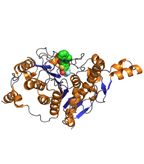SABCS: HDAC Inhibition Sensitizes Triple-Negative Breast Cancer Cells to PARP Inhibition
Combining histone deacetylase (HDAC) inhibitors with PARP inhibitors or cisplatin has the potential to be an effective treatment for triple-negative breast cancer, according to preclinical research presented this week at the San Antonio Breast Cancer Symposium.
Combining histone deacetylase (HDAC) inhibitors with PARP inhibitors or cisplatin has the potential to be an effective treatment for triple-negative breast cancer, according to preclinical research presented this week at the San Antonio Breast Cancer Symposium (SABCS). HDAC inhibition yields molecular changes that make the cancer cells more sensitive to other treatment.

Histone deacetylase 4 catalytic domain; source: A2-33, Wikimedia Commons
“In simple terms, we are trying to cause a ‘BRCAness’ so that you confer on triple-negative breast cancer cells the sensitivity to PARP inhibitors or platinum therapy seen when BRCA1 mutations are present,” said Kapil N. Bhalla, MD, chief of personalized cancer medicine at the University of Kansas Cancer Center in Kansas City. Triple-negative breast cancer is not treatable with standard hormone therapies.
Tumor cells often rely on intact DNA repair pathways, involving proteins including ATR, CHK1, and BRCA1. Those three proteins require heat shock protein 90 (HSP90) to function, and previous work has shown that HDAC inhibition can deactivate HSP90.
“The icing on the cake, so to speak, was that in addition to inhibiting the DNA damage response through depletion of DNA repair proteins, HDAC inhibitors induced DNA damage. By using HDAC inhibitors, we were targeting the cancer two ways at once,” said Bhalla in a press release.
Furthermore, triple-negative cancer cells without BRCA1 mutations have been shown to exhibit greater sensitivity to PARP inhibition and to cisplatin. Combining the effects of the HDAC inhibitor with these other agents can create a “lethal synergy” and help kill the tumor cells.
“If you have a patient with triple-negative breast cancer who does not have a BRCA1 mutation, you could consider a clinical trial using an HDAC inhibitor in combination with a PARP inhibitor and cisplatin,” Bhalla said.
Genetic Variation
Finding better ways to treat triple-negative cancers remains an important challenge. In another study presented at SABCS this week, researchers led by Justin M. Balko, PharmD, PhD, of the Vanderbilt-Ingram Cancer Center in Nashville, found a wide array of genetic variations in triple-negative tumor cells left behind after chemotherapy.
“Unfortunately, about 70 percent of patients still have some residual disease at the time of surgery, despite treatment,” Balko said. “We speculate this residual disease in the breast should look just like simultaneous micrometastases that are destined to recur in the same patient.” In order to work toward targeted therapies and prevent recurrence, the genetic details of these cells are important. At present there are no targeted therapy options for triple-negative breast cancer patients with residual disease after neoadjuvant chemotherapy.
In profiling residual tumor cells in 102 patients (89 were evaluable), Balko and colleagues found a more diverse set of genetic alterations than they expected. “In one way, we fell further down this rabbit hole,” he said. “But we also found some things that could be promising therapeutically, such as frequent MYC, MCL1, and JAK2 amplifications as well as mutations in the PI3K pathway.”
Newsletter
Stay up to date on recent advances in the multidisciplinary approach to cancer.